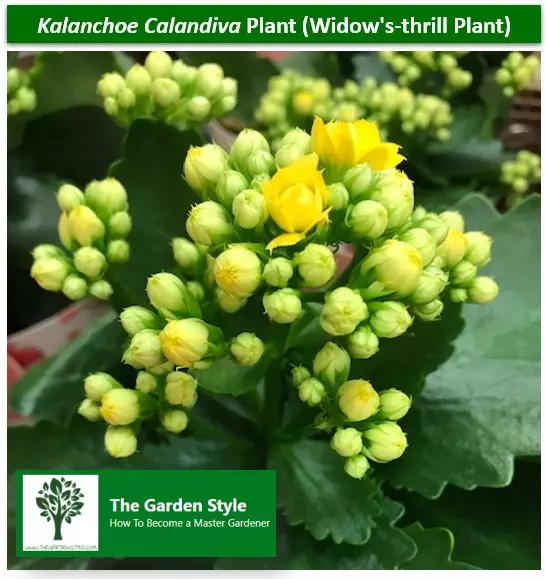Kalandiva or Kalanchoe calandiva plant, known as Widow’s-thrill plant, is a hybrid of Kalanchoe blossfelda, and belongs to the family Crassulaceae. This article summarizes how to grow and care for Kalanchoe calandiva plant (Widow’s-thrill), Caladiva propagation, and blooming troubleshooting.
The Kalandiva or Widow’s-thrill plant is commonly known as Calandiva and is a perennial succulent plant native to Asia, Africa, and Madagascar that has become very popular in Europe and North America thanks to the particular beauty of its small, showy, and long-lasting fragrant flowers.
On previous article, we share care guides for different species of Kalanchoe succuelent plants, such as Kalanchoe pumila, Kalanchoe Tomentosa, and Kalanchoe luciae. This is the time to discuss about the hybrid of Kalanchoe blossfelda, also known as the Widow’s-thrill plant, the Kalanchoe calandiva succulent plant.
This species of Kalanchoe, not exceeding 14 inches (35 cm) in height, is especially popular as a houseplant and ornamental.
This plant has fleshy green oval-shaped leaves with serrated edges and the low care required for its cultivation makes the Kalanchoe calandiva plant a particularly popular plant among all plant lovers.
Calandiva is a double flowering plant, sun resistant, so it can be placed in a sunny spot. Ensure that the plant is kept at a temperature between 63 and 77 F (17 and 25 °C). Regarding watering conditions, it is advisable to ensure that the pots have adequate drainage and water a little every 2-3 days.
Table of Contents
Kalanchoe Calandiva Widow’s-thrill Care
The care of the Kalanchoe calandiva Plant is not very demanding. The plant needs a bright place where direct sunlight is not a problem.
The temperature should be above 53.6 F (12°C) to maintain the flowering cycle and although it is advisable to water it lightly every 2 or 3 days, it is quite resistant to drought with the right substrate it only needs to be watered once every 14 days.
Calandiva is particularly fond of bright environments and requires exposure to direct sunlight for at least a couple of hours a day, although it should be avoided during the hottest hours of the day during the summer.
It is advisable to place the Widow’s-thrill plant away from heat sources and doors or windows that may expose it to cold air currents.
More about How to Care for Kalanchoe Species in this guide.
When does Calandiva Bloom?
Calandiva plant blooms in early spring, between February-March and April, and it can last until July. Its long-lasting flowers can last up to 45 to 60 days and have beautiful inflorescences of various colors.
- Red Calandiva
- Pink Calandiva
- Yellow Calandiva
- Orange Calandiva
- Fuchsia Calandiva

The flowering period lasts from 8 to 10 weeks and in the northern hemisphere occurs from February, March to April, depending on the temperature, just before the arrival of spring.
One thing that is curious about this plant is that, as short-day plants, Kalanchoe calandiva can flower in winter, when the days get shorter. Another tip to keep in mind is that temperatures below 50 F (10 °C) or above 71.6 F (22 °C) can delay flowering and damage the plant.
Why my Kalanchoe Calandiva Plant Is Not Blooming?
Although the Widow’s-thrill plant is not very demanding, it may not flower properly. We see the causes of the non-flowering of the Calandiva plant.
The flowering cycle of the Calandiva plant occurs with a 10-hour photoperiod and buds and buds take about 6 weeks to re-induce.
If you want your Kalanchoe calandiva to rebloom, you can simulate 14 hours of darkness to induce flower bud formation by covering your plant with a black cloth or cardboard box.
On the other hand, if your Calandiva does not flower and only develops soft leaves, you may have overwatered it and caused harmful waterlogging of the soil.
Widow’s-thrill Plant Location: Indoors vs. Outdoors
Although Widow’s-thrill Plant is usually used as an indoor plant, it can also be placed outdoors.
If Kalanchoe calandiva is exposed to full sunlight outdoors, make sure that the leaves or flowers are not sunburned. The best time to place the plant outdoors is from May and June to September and October.
Report the Widow’s-thrill to good potting soil and increase the pot size every year.

How to Propagate the Calandiva Plant (Hybrid Kalanchoe Blossfeldiana)?
Kalanchoe calandiva (Widow’s-thrill) can be reproduced in two ways: by seeds or by cuttings.
Kalanchoe Calandiva Plant Propagation from Seeds
Propagate Calandiva from February to April by collecting the seeds from the dried flowers and burying them in a cactus substrate mixed with sand and peat.
Keep the seedbed in the shade, placing it in an environment of about 68 F (20°C) and moistening it frequently with a nebulizer.
If you want to keep the temperature and humidity constant, cover the potting soil with plastic sheeting until germination is complete.
Kalanchoe Calandiva Propagation from Cuttings
Propagation of Kalanchoe Calandiva cuttings follows the following steps:
- Remove a 4-inches (8-10 cm) piece of the Widow’s-thrill stem with a box cutter, making sure it is free of flowers and flower buds.
- Let the cut piece of Widow’s-thrill Plant dry on blotting paper for a couple of days,
- Fill a small pot with cactus soil mixed in equal parts with sand or vermiculite,
- Bury the cutting in the pot and place it in a room at 68-71.6 F (20-22°C),
- Moisten the soil frequently with a sprayer;
- Cover it with plastic sheeting to insulate the potting soil.
In a few weeks, the Widow’s-thrill Plant cutting will give rise to new buds and a beautiful new Calandiva plant will be ready to bloom.
Repot the Calandiva plant to a larger pot and your home will finally have a new companion.
Learn more about Succulent Propagation by following this link.
Kalanchoe Calandiva Plant Fertilization
Calandiva does not have great nutritional requirements and is a hardy and very rustic plant.
However, like any plant with a flowering cycle, it may require some annual fertilization that can be done from March to September, while during the winter period, it is preferable to suspend it.
As for the fertilizer to be used, it is preferable to choose organic substances with a high concentration of potassium, essential for the flourishing growth of Kalanchoe calandiva, and low in nitrogen, including the following trace elements: phosphorus, iron, manganese, copper, zinc, boron, and molybdenum.
Recommended Post: Fertilizer for Succulents
Widow’s-thrill Plant Repotting
Calandiva should be repotted once a year, preferably after flowering.
For repotting it is recommended to use terracotta pots, to allow the plant to transpire, and to place stones at the bottom to reduce the stagnation of excess water.
The ideal potting soil is the one generally used for succulent plants and should be enriched with sand or vermiculite to promote water drainage. Learn more about Succulents with Yellow Flowers.
